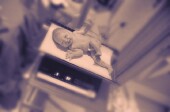 |
 |
 |

Assisted Reproductive Technology Linked to Birth Defects
But the chances of such problems are low, CDC study finds|
|
HealthDay
By Robert Preidt
Monday, November 17, 2008
 MONDAY, Nov. 17 (HealthDay News) -- Compared to naturally conceived infants, those babies conceived with assisted reproductive technology (ART) are two to four times more likely to have certain types of heart defects, cleft lip and gastrointestinal defects.
MONDAY, Nov. 17 (HealthDay News) -- Compared to naturally conceived infants, those babies conceived with assisted reproductive technology (ART) are two to four times more likely to have certain types of heart defects, cleft lip and gastrointestinal defects.
That's the conclusion of a U.S. Centers for Disease Control and Prevention (CDC) study released Monday
ART, which includes in-vitro fertilization, refers to any procedure that involves surgically removing eggs from a woman's womb, combining them with sperm in the laboratory, and returning them to the woman's body or donating them to another woman.
"Today, more than one percent of infants are conceived through ART, and this number may continue to increase. While the risk is low, it is still important for parents who are considering using ART to think about all of the potential risks and benefits of this technology," Jennita Reefhuis, an epidemiologist at the CDC's National Center on Birth Defects and Developmental Disabilities, said in an agency news release.
The researchers compared data from 281 ART-conceived births and 14,095 naturally conceived births. Among pregnancies resulting in a single birth, ART was associated with twice the risk of some types of heart defects, more than twice the risk of cleft lip with or without cleft palate, and more than four times the risk of certain kinds of gastrointestinal defects.
But the researchers noted the absolute risk of a birth defect remains low. For example, cleft lip with or without palate occurs in about one of every 950 births, which means the ART-related increase in risk would result in about one in 425 babies having this defect.
ART didn't significantly increase the risk of birth defects in multiple births. However, ART may have an indirect impact, because it increases the likelihood of twins, which is a risk factor for many types of birth defects. The researchers suggested further study is needed to determine ART-related risk for defects in pregnancies with multiple births.
The study, Assisted Reproductive Technology and Major Structural Birth Defects, United States, was published in the journal Human Reproduction.
ART has been used in the United States since 1981, and the number of infants born after ART doubled from 1996 through 2004. In 2002, almost 12 percent of U.S. women ages 15 to 44 reported using infertility services. In 2005, more than 134,000 ART procedures were performed in the United States, resulting in the birth of about 52,000 babies, the CDC said.
HealthDay
Copyright (c) 2008 ScoutNews, LLC. All rights reserved.
Related News:
More News on this Date
Related MedlinePlus Pages:
| Home | Health Topics | Drugs & Supplements | Encyclopedia | Dictionary | News | Directories | Other Resources | |
| Disclaimers | Copyright | Privacy | Accessibility | Quality Guidelines U.S. National Library of Medicine, 8600 Rockville Pike, Bethesda, MD 20894 National Institutes of Health | Department of Health & Human Services |
Date last updated: 18 November 2008 |




